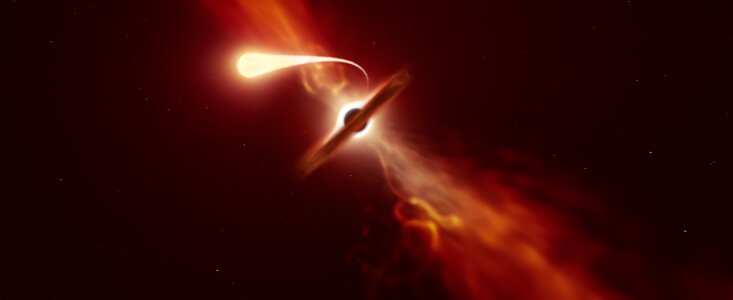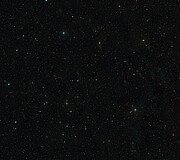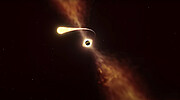Pressemeddelelse
Stjerne lider spaghettidøden. ESO-teleskoper følger dens sidste øjeblikke
12. oktober 2020

En stjerne er flået istykker af et supertungt sort hul, og dens sidste gisp af lys er registreret med teleskoper fra European Southern Observatory (ESO) og andre organisationer. Hændelsen er sket i en galakse 215 millioner lysår borte. Det er det tætteste, astronomerne nogensinde har set sådan et lysglimt, og derfor har de kunnet studere fænomenet i større detaljer end nogensinde før. Forskningsresultatet offentliggøres idag i tidsskriftet Monthly Notices of the Royal Astronomical Society.
"Tanken om, at et sort hul "suger" en nær stjerne til sig, lyder som science fiction. Men det er lige præcis det, der er sket ved det, vi kalder en tidevandsdestruktion," fortæller Matt Nicholl, som underviser og forsker som Royal Astronomical Society fellow ved Birminghams Universitet. Han er hovedforfatter på artiklen. Men disse tidevandsdestruktioner (tidal disruption events på engelsk), hvor en stjerne gennemgår det, som kaldes spaghettificering når den suges ind i et sort hul, er sjældne, og ikke altid så lette at undersøge. Forskerholdet pegede ESOs Very Large Telescope (VLT) og ESOs New Technology Telescope (NTT) mod et nyopdaget lysglimt, som dukkede op sidste år tæt ved et supertungt sort hul, for i detaljer at kunne undersøge, hvad det lige er, der sker, når en stjerne bliver ædt af sådan et monster.
I teorien véd astronomerne godt, hvad der burde ske. "Når en så uheldig stjerne kommer for tæt på et supertungt sort hul i centeret af en galakse, vil den voldsomme tyngdekraft fra det sorte hul flænse stjernen til tynde strimler af materiale," forklarer medforfatter Thomas Wevers, som er ESO Fellow in Santiago, Chile. Han opholdt sig ved Institute of Astronomy, ved universitetet i Cambridge, da han udførte dette arbejde. Når nogle af disse tynde strimler af stjernestof falder ind i det sorte hul under spaghettificeringen, vil der opstå et klart energiglimt, og det kan astronomerne opfange.
Selvom sådan et glimt er kraftigt, har det til nu været besværligt for astronomerne at undersøge. Ofte skjules fænomenet af skyer af støv og stjernerester. Det er først nu, astronomerne har fundet ud af, hvor de skyer stammer fra.
"Vi fandt ud af, at en stjerne, når den bliver ædt af et sort hul, kan udsende en kraftig strøm af stof, som spærrer for vores udsyn," forklarer Samantha Oates, som også arbejder ved Birminghams Universitet. Det sker, fordi den energi, som udsendes, når det sorte hul æder stjernestof, kan presse resterne af stjernen bort.
Den opdagelse var mulig fordi den tidevandsdestruktion, som forskerholdet studerede blev opdaget meget kort tid efter at stjernen var flået istykker. "Vi fangede hændelsen tidligt, og derfor kunne vi simpelthen se, hvordan et gardin af støv og stjernerester blev trukket udad, da det sorte hul udsendte en kraftig strøm af stof med hastigheder op til 10 000 km/sek," siger Kate Alexander, som er NASA Einstein Fellow ved Nortwestern University i USA. "Vores helt unikke 'kig bag forænget' er den første mulighed, der har været for at fastlægge hvor det her materiale kommer fra, og for at følge i realtid hvordan det efterhånden indhyller det sorte hul."
Forskerholdet observerede hændelsen, som kaldes AT2019qiz, i en spiralgalakse i stjernebilledet Eridanus hen over en periode på 6 måneder, hvor lysglimtet voksede i styrke, og så fadede væk. "Der var flere overvågningsprogrammer, som fandt udstråling fra den nye tidevandsdestruktion meget tidligt efter at stjernen var flået istykker," siger Wevers. "Vi pegede med det samme en gruppe af jordbaserede teleskoper og rumteleskoper i den retning, for at finde ud af, hvordan lyset blev dannet."
I løbet af de følgende måneder blev hændelsen observeret flere gange med forskellige instrumenter; blandt andre X-shooter og EFOSC2, som er monteret på ESOs VLT og NTT i Chile. De hurtige og omfattende observationer i ultraviolet, synligt lys, røntgenstråling og radiostråling viste for første gang en direkte forbindelse imellem det stof, som strømmede bort fra stjernen, og det klare lysglimt, som opstod, da den blev opslugt af det sorte hul. "Observationerne viste, at stjernen havde nogenlunde samme størrelse som Solen, og at den mistede omkring halvdelen af sin masse til det store sorte hul, som vejer mere end en million gange mere end det," siger Nicholl, som også er gæsterforsker ved Edinburghs Universitet.
Dette forskningsresultat gør os bedre i stand til at forstå de supertunge sorte huller, og hvordan stof opfører sig i de ekstremt kraftige tyngdefelter omkring dem. Forskerholdet fortæller, at AT2019qiz endog kan være en slags 'Rosettasten', som kan hjælpe med til at fortolke fremtidige observationer af tidevandsdestruktioner. ESOs Ekstremely Large Telescope (ELT), som efter planen skal tages i brug i dette årti, vil kunne bruges af forskerne til at finde endnu svagere og hurtigere tidevandsdestruktioner, og dermed løse flere af de uforklarede problemer i de sorte hullers fysik.
(Det er måske på sin plads at bemærke, at vi på dansk kun har begrebet "tidevand" til at dække det engelske ord "tides". Men fænomenet beskriver forskelle i tyngdekraftspåvirkning, og har altså i dette tilfælde intet med vand at gøre! oversætteren ESON-Danmark)
Mere information
Forskningsresultaterne her er offentliggjort i en artikel med titlen “An outflow powers the optical rise of the nearby, fast-evolving tidal disruption event AT2019qiz” i tidsskriftet Monthly Notices of the Royal Astronomical Society (doi: 10.1093/mnras/staa2824).
Forskerholdet består af M. Nicholl (Birmingham Institute for Gravitational Wave Astronomy and School of Physics and Astronomy, University of Birmingham, UK [Birmingham] og Institute for Astronomy, University of Edinburgh, Royal Observatory, UK [IfA]), T. Wevers (Institute of Astronomy, University of Cambridge, UK), S. R. Oates (Birmingham), K. D. Alexander (Center for Interdisciplinary Exploration and Research in Astrophysics and Department of Physics and Astronomy, Northwestern University, USA [Northwestern]), G. Leloudas (DTU Space, Danmark [DTU]), F. Onori (Istituto di Astrofisica e Planetologia Spaziali (INAF), Roma, Italien), A. Jerkstrand (Max-Planck-Institut für Astrophysik, Garching, Germany and Department of Astronomy, Stockholm University, Sverige [Stockholm]), S. Gomez (Center for Astrophysics | Harvard & Smithsonian, Cambridge, USA [CfA]), S. Campana (INAF–Osservatorio Astronomico di Brera, Italien), I. Arcavi (The School of Physics and Astronomy, Tel Aviv University, Israel and CIFAR Azrieli Global Scholars program, CIFAR, Toronto, Canada), P. Charalampopoulos (DTU), M. Gromadzki (Astronomical Observatory, University of Warsaw, Polen [Warsaw]), N. Ihanec (Warsaw), P. G. Jonker (Department of Astrophysics/IMAPP, Radboud University, Nederlandene [Radboud] and SRON, Netherlands Institute for Space Research, Nederlandene [SRON]), A. Lawrence (IfA), I. Mandel (Monash Centre for Astrophysics, School of Physics and Astronomy, Monash University, Australien og The ARC Center of Excellence for Gravitational Wave Discovery – OzGrav, Australien and Birmingham), S. Schulze (Department of Particle Physics and Astrophysics, Weizmann Institute of Science, Israel [Weizmann]) P. Short (IfA), J. Burke (Las Cumbres Observatory, Goleta, USA [LCO] og Department of Physics, University of California, Santa Barbara, USA [UCSB]), C. McCully (LCO and UCSB) D. Hiramatsu (LCO and UCSB), D. A. Howell (LCO og UCSB), C. Pellegrino (LCO and UCSB), H. Abbot (The Research School of Astronomy and Astrophysics, Australian National University, Australien [ANU]), J. P. Anderson (European Southern Observatory, Santiago, Chile), E. Berger (CfA), P. K. Blanchard (Northwestern), G. Cannizzaro (Radboud and SRON), T.-W. Chen (Stockholm), M. Dennefeld (Institute of Astrophysics Paris (IAP), and Sorbonne University, Paris), L. Galbany (Departamento de Física Teórica y del Cosmos, Universidad de Granada, Spanien), S. González-Gaitán (CENTRA-Centro de Astrofísica e Gravitação and Departamento de Física, Instituto Superior Técnico, Universidade de Lisboa, Portugal), G. Hosseinzadeh (CfA), C. Inserra (School of Physics & Astronomy, Cardiff University, UK), I. Irani (Weizmann), P. Kuin (Mullard Space Science Laboratory, University College London, UK), T. Muller-Bravo (School of Physics and Astronomy, University of Southampton, UK), J. Pineda (Departamento de Ciencias Fisicas, Universidad Andrés Bello, Santiago, Chile), N. P. Ross (IfA), R. Roy (The Inter-University Centre for Astronomy and Astrophysics, Ganeshkhind, India), S. J. Smartt (Astrophysics Research Centre, School of Mathematics and Physics, Queen’s University Belfast, UK [QUB]), K. W. Smith (QUB), B. Tucker (ANU), Ł. Wyrzykowski (Warsaw), D. R. Young (QUB).
ESO er den fremmeste fællesnationale astronomiorganisation i Europa, og verdens langt mest produktive jordbaserede astronomiske observatorium. 16 lande er med i ESO: Belgien, Danmark, Finland, Frankrig, Irland, Italien, Nederlandene, Polen, Portugal, Spanien, Sverige, Schweiz, Storbritannien, Tjekkiet, Tyskland og Østrig, og desuden værtsnationen Chile. Australien er med som strategisk partner. ESO har et ambitiøst program, som gør det muligt for astronomer at gøre vigtige videnskabelige opdagelser. Programmet har focus på design, konstruktion og drift af stærke jordbaserede observatorier. Desuden har ESO en ledende rolle i formidling og organisering af samarbejde omkring astronomisk forskning. ESO driver tre enestående observatorier i verdensklasse i Chile: La Silla, Paranal og Chajnantor. På Paranal driver ESO VLT, Very Large Telescope, som er verdens mest avancerede observatorium for synligt lys, samt to oversigtsteleskoper. VISTA, som observerer i infrarødt, er verdens største oversigtsteleskop, og VLT Survey Teleskopet er det største teleskop bygget til at overvåge himlen i synligt lys. På Paranal bliver ESO tillige vært for og operatør af Cherenkov Telescope Array South , som bliver Verdens største og mest følsomme gammastråleobservatorium. ESO er også en af de største partnere på Chajnantorhøjsletten, APEX ogi ALMA, som er det største eksisterende astronomiprojekt. For tiden bygges ELT, et 39 m optisk og nærinfrarødt teleskop på Cerro Armazones, tæt ved Paranal. Det bliver "verdens største himmeløje".
Links
- Hele forskningsartiklen
- Fotos af VLT
- Fotos af NTT
- Er du forsker, og har du en god historie, så kontakt os
Kontakter
Matt Nicholl
School of Physics and Astronomy and Institute of Gravitational Wave Astronomy, University of Birmingham
Birmingham, UK
E-mail: m.nicholl.1@bham.ac.uk
Thomas Wevers
European Southern Observatory
Santiago, Chile
E-mail: Thomas.Wevers@eso.org
Samantha Oates
Institute of Gravitational Wave Astronomy, University of Birmingham
Birmingham, UK
E-mail: sroates@star.sr.bham.ac.uk
Kate Alexander
Center for Interdisciplinary Exploration and Research in Astrophysics and Department of Physics and Astronomy, Northwestern University
Evanston, USA
E-mail: kate.alexander@northwestern.edu
Bárbara Ferreira
ESO Public Information Officer
Garching bei München, Germany
Tel: +49 89 3200 6670
Mobil: +49 151 241 664 00
E-mail: pio@eso.org
Ole J. Knudsen (Pressekontakt Danmark)
ESOs formidlingsnetværk
og Aarhus Space Centre, Aarhus Universitet
Aarhus, Danmark
Tel: +45 8715 5597
E-mail: eson-denmark@eso.org
Om pressemeddelelsen
| Pressemeddelelse nr.: | eso2018da |
| Navn: | AT2019qiz |
| Type: | Local Universe : Star : Evolutionary Stage : Black Hole |
| Facility: | New Technology Telescope, Very Large Telescope |
| Instruments: | EFOSC2, X-shooter |
| Science data: | 2020MNRAS.499..482N |
Our use of Cookies
We use cookies that are essential for accessing our websites and using our services. We also use cookies to analyse, measure and improve our websites’ performance, to enable content sharing via social media and to display media content hosted on third-party platforms.
ESO Cookies Policy
The European Organisation for Astronomical Research in the Southern Hemisphere (ESO) is the pre-eminent intergovernmental science and technology organisation in astronomy. It carries out an ambitious programme focused on the design, construction and operation of powerful ground-based observing facilities for astronomy.
This Cookies Policy is intended to provide clarity by outlining the cookies used on the ESO public websites, their functions, the options you have for controlling them, and the ways you can contact us for additional details.
What are cookies?
Cookies are small pieces of data stored on your device by websites you visit. They serve various purposes, such as remembering login credentials and preferences and enhance your browsing experience.
Categories of cookies we use
Essential cookies (always active): These cookies are strictly necessary for the proper functioning of our website. Without these cookies, the website cannot operate correctly, and certain services, such as logging in or accessing secure areas, may not be available; because they are essential for the website’s operation, they cannot be disabled.
Functional Cookies: These cookies enhance your browsing experience by enabling additional features and personalization, such as remembering your preferences and settings. While not strictly necessary for the website to function, they improve usability and convenience; these cookies are only placed if you provide your consent.
Analytics cookies: These cookies collect information about how visitors interact with our website, such as which pages are visited most often and how users navigate the site. This data helps us improve website performance, optimize content, and enhance the user experience; these cookies are only placed if you provide your consent. We use the following analytics cookies.
Matomo Cookies:
This website uses Matomo (formerly Piwik), an open source software which enables the statistical analysis of website visits. Matomo uses cookies (text files) which are saved on your computer and which allow us to analyze how you use our website. The website user information generated by the cookies will only be saved on the servers of our IT Department. We use this information to analyze www.eso.org visits and to prepare reports on website activities. These data will not be disclosed to third parties.
On behalf of ESO, Matomo will use this information for the purpose of evaluating your use of the website, compiling reports on website activity and providing other services relating to website activity and internet usage.
Matomo cookies settings:
Additional Third-party cookies on ESO websites: some of our pages display content from external providers, e.g. YouTube.
Such third-party services are outside of ESO control and may, at any time, change their terms of service, use of cookies, etc.
YouTube: Some videos on the ESO website are embedded from ESO’s official YouTube channel. We have enabled YouTube’s privacy-enhanced mode, meaning that no cookies are set unless the user actively clicks on the video to play it. Additionally, in this mode, YouTube does not store any personally identifiable cookie data for embedded video playbacks. For more details, please refer to YouTube’s embedding videos information page.
Cookies can also be classified based on the following elements.
Regarding the domain, there are:
- First-party cookies, set by the website you are currently visiting. They are stored by the same domain that you are browsing and are used to enhance your experience on that site;
- Third-party cookies, set by a domain other than the one you are currently visiting.
As for their duration, cookies can be:
- Browser-session cookies, which are deleted when the user closes the browser;
- Stored cookies, which stay on the user's device for a predetermined period of time.
How to manage cookies
Cookie settings: You can modify your cookie choices for the ESO webpages at any time by clicking on the link Cookie settings at the bottom of any page.
In your browser: If you wish to delete cookies or instruct your browser to delete or block cookies by default, please visit the help pages of your browser:
Please be aware that if you delete or decline cookies, certain functionalities of our website may be not be available and your browsing experience may be affected.
You can set most browsers to prevent any cookies being placed on your device, but you may then have to manually adjust some preferences every time you visit a site/page. And some services and functionalities may not work properly at all (e.g. profile logging-in, shop check out).
Updates to the ESO Cookies Policy
The ESO Cookies Policy may be subject to future updates, which will be made available on this page.
Additional information
For any queries related to cookies, please contact: pdprATesoDOTorg.
As ESO public webpages are managed by our Department of Communication, your questions will be dealt with the support of the said Department.





